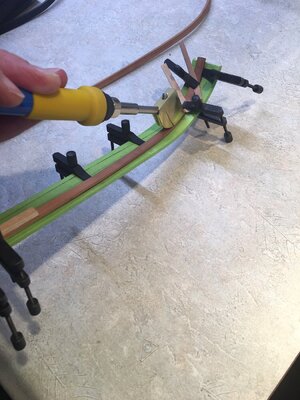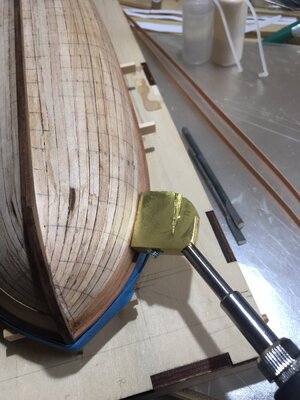I agree on water and CA, wet wood sticks better than dry in my experience with it (at least with the ones I have used)
-

Win a Free Custom Engraved Brass Coin!!!
As a way to introduce our brass coins to the community, we will raffle off a free coin during the month of August. Follow link ABOVE for instructions for entering.
You are using an out of date browser. It may not display this or other websites correctly.
You should upgrade or use an alternative browser.
You should upgrade or use an alternative browser.
Adhesives for thin planks
- Thread starter Steviedean
- Start date
- Watchers 17
I wet my parts with accelerator spray before putting in place.I agree on water and CA, wet wood sticks better than dry in my experience with it (at least with the ones I have used)
Plain water works as an accelerator for CA.
- Joined
- Oct 12, 2019
- Messages
- 144
- Points
- 78

Hi everybody,
The purple glue sticks can be UHU, Elmers or other off brands sold in the craft section of many stores. About the hold over time, I have used glue sticks to adhere tissue ( prior to shrinking the tissue taught) on balsa stick models for years-no issues with failing. Also used in applying insignia, striping and tissue over tissue markings.
The veneers are so thin, if fitted well should adhere the same I feel....time will tell.
Steviedean
The purple glue sticks can be UHU, Elmers or other off brands sold in the craft section of many stores. About the hold over time, I have used glue sticks to adhere tissue ( prior to shrinking the tissue taught) on balsa stick models for years-no issues with failing. Also used in applying insignia, striping and tissue over tissue markings.
The veneers are so thin, if fitted well should adhere the same I feel....time will tell.
Steviedean
I'm surprised at the things said about contact cement. I've been using it for 2nd layer planking for 30 odd years and never had an issue. Like the rest of building models, a bit of patience is all that's needed.
I don't have much experience but my first planking and second layer planking went well using little brass "add-on" i've made for my temperature controlled soldering iron. Even cherry 2x6mm plank i was able slowly bent to shape. Gluing wet planks with tidebond wood glue and using same iron on lower temperature to "dry" the glue. Planks didn't change color, ironed glue is holding as good as natural dry.




I use a dot of CA at the stem and then more or less on at each bulkhead location down along the line of the plank, applied as a dot with a toothpick. The quickly in between I put a thin line of PVA 10 minute carpenter glue -- kind of connect-the-dots but I dont quite touch the CA dots with the PVA. Then I hold the plank in place at the stem and work on my way down towars the stern, stopping 10 sec or so at each bulkhead to let the CA grip the wood and act like a tack. I do pre-bend my planks either with an Amatie nipped or with an old Aeropiccola electric bender. I dont like to soak because of shrinkage as it dries, which can lead to gaps. Anyway, once the PCA and CA hace set on each plank, in 10 minutes, it is not going anywhere and I can do another. I don't do more that 2 planks per side at a sitting. My $0.02 based on limited experience, but it has worked for me.
My favorite technique for gluing planks is similar, Tango, and involves using WeldBond and Locktite’s brand of gel CA.. Lay down some dots of the white Weldbond, and place small dots of the gel CA in between. Press the plank in place for a rapid bond. The CA acts like a chemical clamp until the WeldBond dries. If you want a quicker grab, lightly moisten the inside surface of Thea plank to act as an accelerant. Practice before using on a model. It works.
Last edited:
I wouldn't use anything but PVA for planking--you can wipe off any excess/stains with water and it's sure to last. The downside is that is takes a while to dry. I have used my electric plank bender to accelerate drying and that works but you have to be delicate because it can discolour the wood or alter the finish a bit.
Slow patient bending with a light touch is essential for my own bending. Nicely done for your first. RichI don't have much experience but my first planking and second layer planking went well using little brass "add-on" i've made for my temperature controlled soldering iron. Even cherry 2x6mm plank i was able slowly bent to shape. Gluing wet planks with tidebond wood glue and using same iron on lower temperature to "dry" the glue. Planks didn't change color, ironed glue is holding as good as natural dry.
View attachment 218269View attachment 218270
I use gel CA. Start at one end with a drop of gel CA...work across the curve using drops of the gel CA. I hold the plank in place with my finger for a ten count as the CA gel sets and move on to the next glue point...repeat...
This is esentially what I do too. I also use accelerator spray as needed on particularly difficult parts. If I had to wait for PVA glues to fully cure, my build would take months!I use gel CA. Start at one end with a drop of gel CA...work across the curve using drops of the gel CA. I hold the plank in place with my finger for a ten count as the CA gel sets and move on to the next glue point...repeat...
CA and PVA glues are quite compatible. Using PVA with gel CA as a "tack" allows the plank to be fixed in seconds...then move on to the next. Because of the PVA he plank will still hold in the event of a vibratory or concussive force on it...a weakness of CA glues as a class,This is esentially what I do too. I also use accelerator spray as needed on particularly difficult parts. If I had to wait for PVA glues to fully cure, my build would take months!
I would use CA cautiously, some of the blends (if not most) penetrate the wood and create blobs. You will hard time stain\oil this spot. Even after painting it will leave the ugly spot. I would test the CA glue first.
You have the same problem with PVA glues. I use TiteBond for full size furniture construction. If you plan to stain, you had better get every single spot of the glue off the wood, because, once dry, the TiteBond will not allow ANY stain to penetrate. The only way to remove it is to chisel/plane it off, down to bare wood again.I would use CA cautiously, some of the blends (if not most) penetrate the wood and create blobs. You will hard time stain\oil this spot. Even after painting it will leave the ugly spot. I would test the CA glue first.
I've used Titebond I,II,III for over 25 years here and have done woodworking for almost 60 years. Squeeze out is always a consideration. Setup time is an issue in modelling to me. So, I'll stick with CA. I've seen no emperical data on CA failure or issues concerning longevity. We'll see what happens....You have the same problem with PVA glues. I use TiteBond for full size furniture construction. If you plan to stain, you had better get every single spot of the glue off the wood, because, once dry, the TiteBond will not allow ANY stain to penetrate. The only way to remove it is to chisel/plane it off, down to bare wood again.
It is a little bit different behavior, Dave. CA penetrates the wood and you absolutely cannot remove it (unless replacing that piece). With TiteBond, those spots on top, and can be removed while wet or scrape when dry. For my modeling purposes, I never use TiteBond 1,2, and 3. Most times I use Elmer's MAX and LinecoYou have the same problem with PVA glues. I use TiteBond for full size furniture construction. If you plan to stain, you had better get every single spot of the glue off the wood, because, once dry, the TiteBond will not allow ANY stain to penetrate. The only way to remove it is to chisel/plane it off, down to bare wood again.
- Joined
- Feb 21, 2020
- Messages
- 103
- Points
- 58

I use two part, five min. epoxy. I let the mixed parts stand for a couple or three minutes, and hold it until the glue sets.
I don’t use TiteBond either. I use WeldBond. Stays somewhat flexible and squeeze out is easy to deal with.It is a little bit different behavior, Dave. CA penetrates the wood and you absolutely cannot remove it (unless replacing that piece). With TiteBond, those spots on top, and can be removed while wet or scrape when dry. For my modeling purposes, I never use TiteBond 1,2, and 3. Most times I use Elmer's MAX and Lineco
For my Alert build, I use Gorilla glue. It holds very strong within a few min. The more I use it, the more I liked it. WeldBond was never got accustomed to my shipyard, for some reason. I try a few times but never liked the result.







